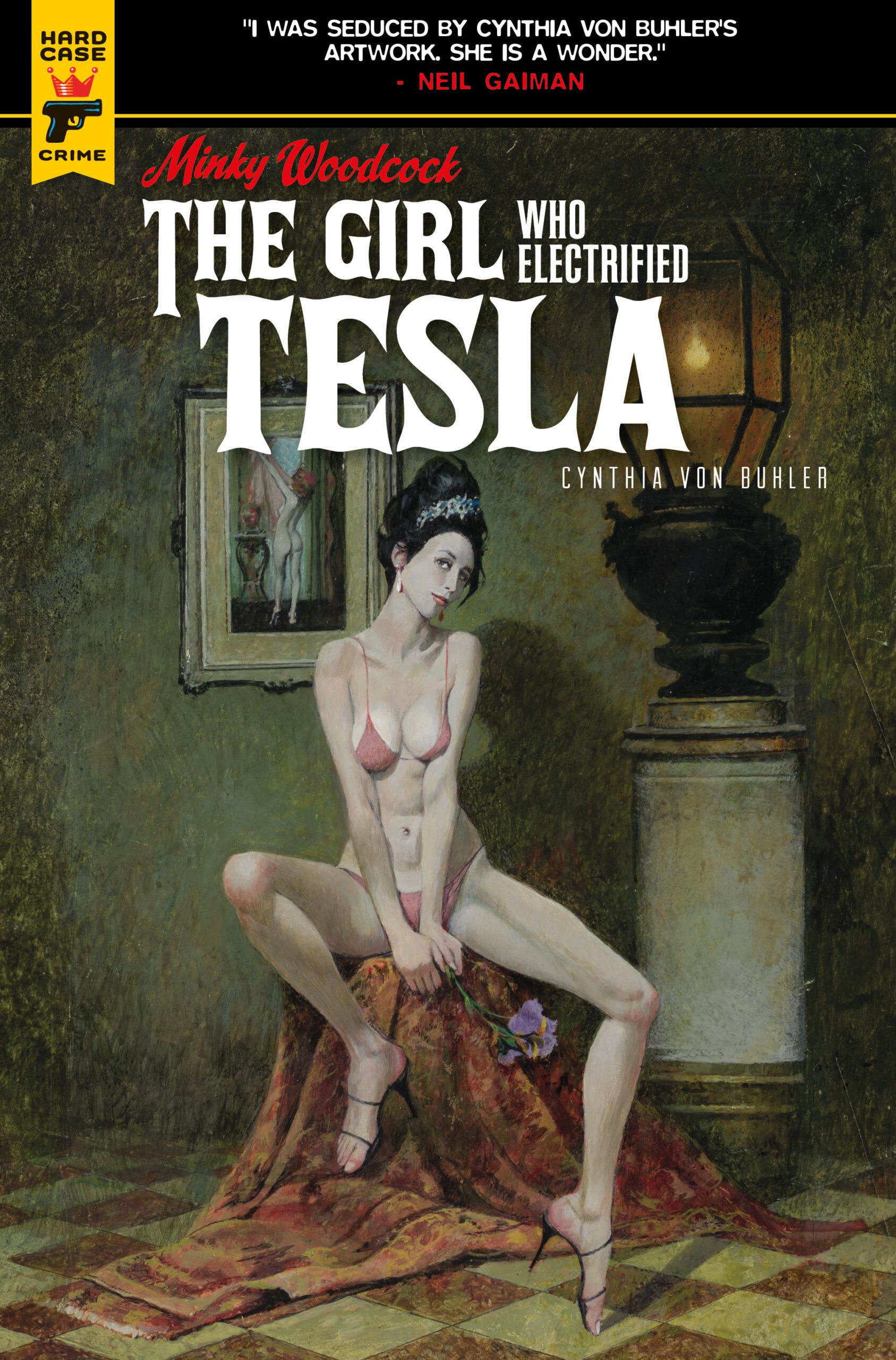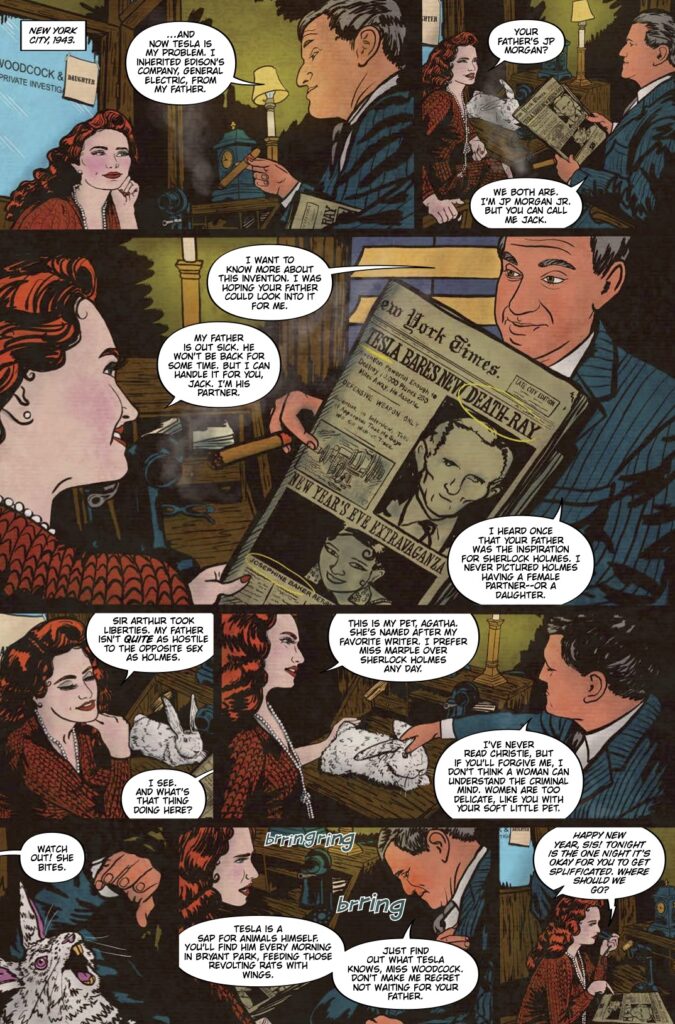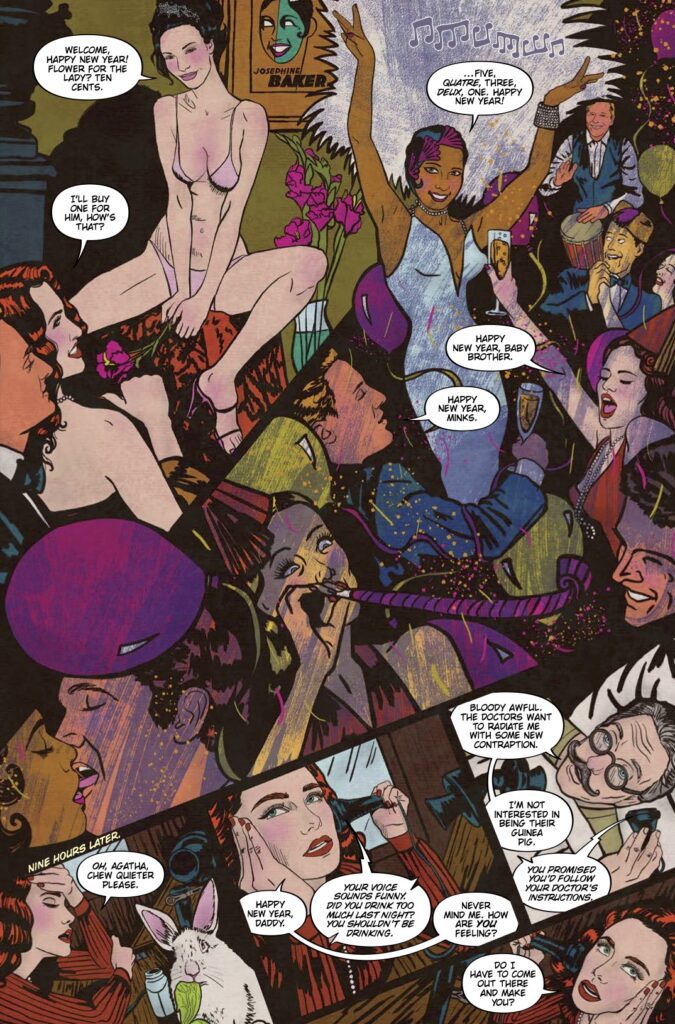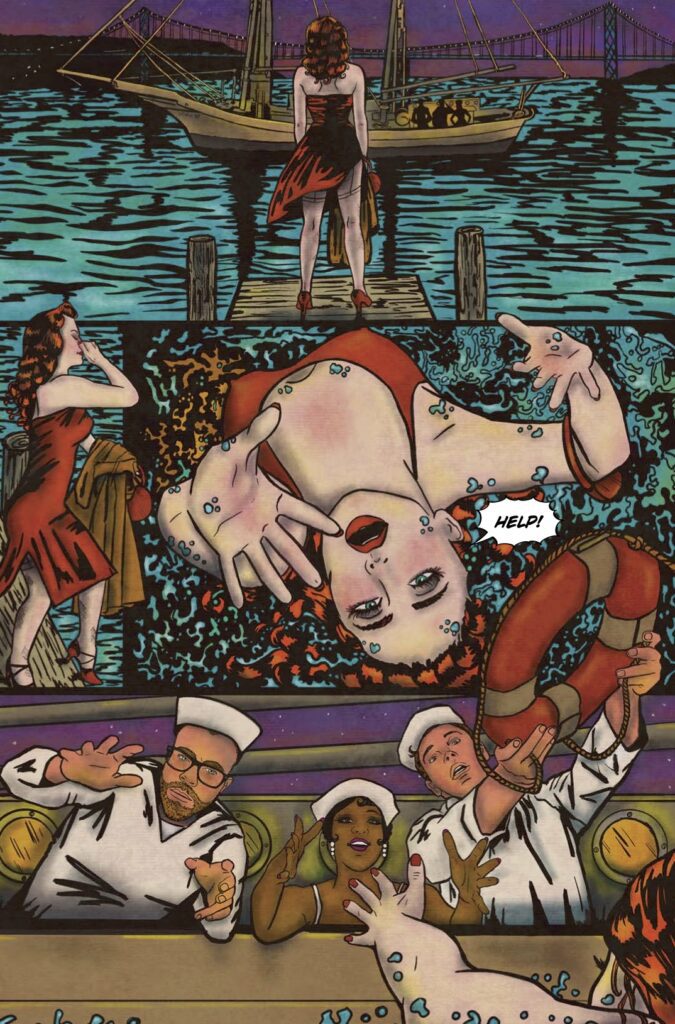
Minky Woodcock: The Girl Who Electrified Tesla is the second volume in this electrifying series from Titan Comics and the brilliant mind of Cynthia Von Buhler! I had the pleasure of interviewing Cynthia to talk all about this brilliant historical fiction graphic novel! Check out the press release from Titan Comics below, then read on to have all your questions answered by Cynthia herself!
“Cynthia von Buhler’s latest graphic novel is woven around little-known historical facts such as Nazi interest in Nikola Tesla’s death ray, Josephine Baker’s spy activity during WWII, and Donald Trump’s uncle’s involvement following Tesla’s mysterious death. Minky’s new adventure is set during World War II, nearly two decades after the events of the first volume (Minky Woodcock: The Girl Who Handcuffed Houdini), and pits the talented female detective against another sinister and twisted conspiracy when she gets involved with world-renowned inventor Nikola Tesla, Nazi agents, and the race to command the world’s first weapon of mass destruction.”
Story
Congrats on the second volume in the world of Minky Woodcock! For those that don’t know, what is the premise behind the world of Minky Woodcock?
Thank you! Minky Woodcock is a private detective working in her father’s office. Her father, the inspiration behind Sherlock Holmes, doesn’t take her seriously enough even though she is an excellent sleuth. In this episode, we step ahead two decades to 1943 as the last time we saw Minky, she was a very young rookie. These are investigations by a fictional character based on historical facts surrounding mysterious true crimes.
The first volume of Minky Woodcock focused on uncovering the mystery behind the final days of magician Harry Houdini, while this one focuses on the mystery behind Tesla and his death ray. What inspired you to choose these mysteries?
Both Houdini and Tesla are amazing men who died suspiciously. I wanted to dive deep into the details leading up to their deaths. I’ve always been fascinated by Houdini, and like him, I don’t believe in spiritualists. Houdini didn’t like how spiritualists were preying on people who sought to speak with their deceased loved ones. Tesla wanted to invent clean, free power and was thwarted by greedy power-hungry men. Both of these men were on the side of good, not evil, and were trying to make the world a better place.
We often see stories that focus on mother/daughter or father/son relationships, but this one focuses on the less-seen father/daughter relationship. How did you approach writing this familial relationship in the time period of the 1940s with some modern flair to it?
That’s an interesting question. Vintage pulp books are gorgeous, thrilling, fun – and often filled with repulsive sexist tropes. I wanted to create a book steeped in a vintage period with a strong female heroine who battles against sexism not only from the outside world but from the person she loves the most, her father. It’s more visceral and painful coming from a parent, a person whose respect is important to your sense of self-worth. To make it even harder, her father is an incredibly successful private detective. As an Italian American, I grew up seeing women in subservient roles. My uncles would sit around the dinner table telling stories, laughing, smoking cigars, and drinking espresso while my aunts cleaned up the dishes in the kitchen. I’d sit on my dad’s lap. He’d let me take a puff on his cigar and sip his espresso. He went off to work and did important things during the day. This is what I wanted to be doing, not cleaning, caring for babies, and cooking. These ideas are changing now, thankfully, but we are still dealing with sexism. I wanted to write about sexism of the past and how strong women like Minky paved the way for us today. How does her father’s upbringing and experience of earlier times reflect upon his modern daughter? How does she teach him and bring him up to speed? Maybe deep inside, Benedict Woodcock knew all along that women were equal, and often better than men, in typically male-dominated roles and Minky helps him realize and admit this. Meanwhile, Minky’s brother wants to be a dancer on Broadway, not a private detective. Part of my goal is to explore non-conforming gender roles and gender stereotypes.
There’s a common theme throughout the story of wanting to change the world for the better. Is this meant to be a social commentary not only on the past time period but also today? What made you choose this as an overarching theme of the story?
The theme of this episode is power and greed dominating over changing the world for the better. Tesla was forced into focusing his energy on inventing a weapon of mass destruction in order to gain funding for the projects he was really interested in, such as a free energy source. Naively, and perhaps hopefully, Telsa thought the death ray would be a deterrent to war. He saw it as a peace ray. Minky and Josephine Baker weren’t as gullible. To this day, we are dealing with greed and power dominating the creation of a better world. Climate change, war, poverty, and the like aren’t going to be stopped unless we change our greedy ways. Minky was paid for her work, as she should be, but the two heroines in this book choose good over evil.
You’ve said, “As with the Houdini episode, all the anecdotes related to Tesla’s life in my book are based on fact. I really love finding bizarre, unbelievable facts and weaving them into my stories.” Can you tease one unbelievable fact that you’ve interwoven into this story that you’d have to read to believe?
Here are three. There are many more facts like this in the book, but I don’t want to reveal spoilers.
1) Donald Trump’s uncle was involved in the confiscation of Tesla’s personal effects and papers after Tesla’s mysterious death in the New Yorker Hotel.
2) Nikola Tesla was in love with a pigeon and referred to her as his wife.
3) Legendary singer and dancer Josephine Baker was a spy for the French against the Nazis during World War II.
Can we expect another Minky Woodcock mystery in the future? Any tease as to what historical context it’ll be set in?
I have one in the works about the mysterious poisoning death of the world’s first flapper and “the most beautiful girl in the world,” Olive Thomas, who angered her lover Florenz Ziegfeld when she married Jack Pickford. Back then, many Broadway girls died young due to sexism, unrealistic beauty expectations, and violence.
Characters
Tesla’s characterization is an odd but realistic balance of a pigeon-lover who wants to live a simple life and a scientist who can only think and see in numbers and particles. How did you go about characterizing such a historically important character? How much of his characterization is “real”?
The Tesla in my book is completely based on facts. He was a scientific genius suffering from Obsessive Compulsive Disorder who happened to be in love with a pigeon. Much of his dialogue is inspired by actual quotes. He respected women, loved animals, loved to invent, and wanted his inventions to help humankind. Telsa lived and died in the New Yorker hotel. Did he die with a pigeon on his chest? I don’t know. However, a maid did enter his room to clean even though he had a “do not disturb” sign on the door because he was known to have messy pigeons living in his rooms. There are so many details in this book that are based on facts. Even the skating rink at the New Yorker hotel and the numerologist Rhonda who worked there were real. I’m currently making an evidence section on the MinkyWoodcock.com website for this case as I did for the Houdini death.
How did you go about writing Edison’s characterization, as he is seen through the lens of Tesla throughout this story?
Edison has a minor appearance in this story via flashbacks. He was dead by the time my story took place. However, when he was alive, he did thwart Telsa constantly. Edison was deeply jealous and insecure about Tesla’s inventions and creative intelligence. Many films and books have focused on their competition. That wasn’t my intention here. Everything about Edison depicted in my book is true. He offered Tesla money for a specific task, and when it was completed, Edison said he had been joking. He did electrocute animals to make Tesla look bad. That is sociopathic.
Minky Woodcock is never deterred by the majority of the male characters’ sexism, even her own father’s internalized sexism. However, she almost never calls it out for what it is. She simply just keeps rolling and doing her thing. How did you approach writing a woman in this time period?
When everyone around you is sexist, it’s really hard to call it out. Back then, she would have been laughed at (or worse), and it wouldn’t have been believable. Women nowadays don’t realize just how bad it used to be. We stand on the shoulders of those who came before us. Back then, just taking a job was an act of defiance. Taking one in a typically male field was unheard of.
Speaking of women, Josephine Baker was a prominent performer and French spy at the time. She and Minky seem to quickly bond in this story. Why did you choose Josephine Baker specifically? Were there other women spies you could’ve chosen?
I love the fact that Josephine was actually a spy during WWII. She was also bisexual, married to a Jewish man, and fighting against rampant racism. Can you imagine battling racism, sexism, homophobia, and antisemitism all at the same time back then? It’s bad enough today. Baker is an incredible woman. I could do a whole book just about her. I adore her.
More than ever, the Trump family is currently under heavy scrutiny. What was it like writing Donald Trump’s uncle as a character in this story, especially knowing the Trump family today?
According to my research, John Trump didn’t appear to be a bad man, and I didn’t write him as one. He was trying to cure cancer, after all. I found it surprising that he showed up in history here. My research indicated that he didn’t really want to be involved. I don’t think he really had a choice in helping the FBI. If the FBI needs your help, you can’t really say no.
Another important historical figure, Otto Skorzeny, makes a prominent appearance. Why was he chosen over other Nazi figures?
He was around during this time period, and he was known for infiltrating behind enemy lines, wearing the enemy uniform, espionage, and sabotage. He also liberated Mussolini in 1943. Skorzeny was a handsome, confident man, and I could see Minky being attracted to him if she didn’t know he was a Nazi.
Art
Why do you choose to do almost everything, minus the lettering — writing, art, colors — for Minky Woodcock, yourself?
I suppose because I can. A good part of the storytelling in comics is done through the pictures and color. Rather than explain to another person what I want, I can just do it myself. I’ve been an award-winning artist for decades. I was a professional artist before I was a professional writer. I do enjoy having other amazing artists interpret variant covers. I was lucky to have the legend Robert McGinnis paint the cover of this book. He’s partial to brunettes, though! But I don’t mind because although I sometimes dye my hair red, I’m naturally dark-haired.
There’s a certain texture to the surroundings in this book and to each character’s face. It looks beautifully raw! What tools did you use to create the art and colors for this book?
Thank you for noticing. I wanted the book to look like it was an old pulp comic. I draw on textured paper and use texture overlays on top of my finished art. A person cannot tell the difference between a Minky drawn on paper versus a Minky drawn on “paper” on my iPad. The technology of the new iPad pen finally feels like a lead pencil or ink brush in my hand, so I can work in my art studio on paper or on a plane on the iPad. I draw the images in black and white first and do all the coloring on the iPad. I made a video showing how I draw the pages and try out color options. You can check it out here.
There’s a dark aura found in the book, particularly with the dark brown and red tones throughout. How did you go about choosing the color palette for this book?
I’m a painter, and I tend to use colors that remind me of my paints. Deep ochres and rich cadmiums. I’m not a fan of primary colors, and I try to use colors actually found in nature.
There’s a page where we see a horse electrocuted. At first, I thought I was looking at a unicorn or something! Did you intend for this page, or any other page, to have a “magical” look to it?
Ha ha! That’s funny. I adore animals, and I think they ARE magical. There’s the electrocuted horse and the dog and a pigeon taken by a hawk (although no animals were hurt in the making of this book). The death of innocents foreshadows the impending death of Tesla. Honestly, for this page, I was mostly trying to show how electricity looks in a dark room. I was playing around with a variety of approaches, and I left almost all of my experiments in. Do you like it? Maybe I went overboard on that page.
There are so many great moments where if the reader looks at only one piece of what’s happening in the image, they’ll miss an imperative detail about something else, what REALLY is happening. What made you decide to take the subtle approach at times to make sure the reader was paying attention to the full picture?
Yes! See, this is why the writer needs to be the artist. It’s an investigation of a possible crime. There are forensic clues and details everywhere. You can go back and read it again and find new things on almost every page.
Through action sequences, the transitions between panels seem to happen over a longer period of time — sometimes minutes instead of seconds. What made you choose to draw transitions this way?
I like to experiment with panels and not always do them in a traditional squared-off fashion. In one of my immersive plays, I would have all of the action stops when the main character is shot. All the actors would freeze except for the main actor and his son, who have a poignant conversation at this moment. They say that when you are dying or badly injured, you can experience that moment slowed down. I suppose I take a cinematic or theatrical approach to my art sometimes. A car crash can be incredibly beautiful with glass flying and light reflections. I like drawing these moments rather than racing past them.
You have a very specific way of coloring skin tone on your characters, which I really appreciate. You have a way of patterning blush throughout a person’s face, or even their entire body, depending on the circumstance of the moment. What has caused you to take this approach in your art?
That’s perceptive of you. I personally often have pink flushed cheeks. I think you can show emotions through that – anger, shyness, excitement, embarrassment. We also blush on our chests, hands, and other areas in times of great emotion or physicality.
I always love seeing how women draw themselves versus how men draw them. What’s important to you about drawing women well?
I love drawing women. Women are gorgeous. I’m bisexual, so I can appreciate the beauty in both sexes. I like all shapes of women. I’ve never seen a naked woman who wasn’t beautiful. I don’t like to exaggerate women too much like many superhero comics do. I like normal-looking female bodies. No fake Kim Kardashian butt-to-waist ratio, thank you very much. Now, real bodies, that’s what I like to draw.
Do you believe it is more important to draw more true to the time period or more true to the genre?
Oh, interesting question! I like to take both into consideration. However, I think I’d choose genre over period. I love the ridiculously precarious situations, implausibly survivable disasters, and the powerful female body language of the pulp genre.
You can order your copy of Minky Woodcock: The Girl Who Electrified Tesla anywhere here
Check out Cynthia Von Buhler on her website here
Big thanks To Cynthia Von Buhler for answering my questions!




